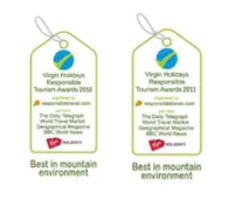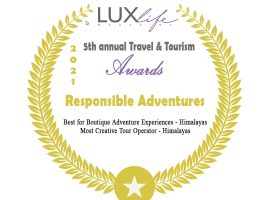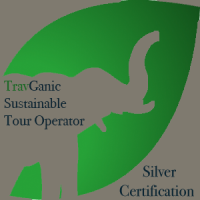Partnership of LGBTQ+ Tour Operators and Nepal Adventure Travel Company
Partnership of LGBTQ+ Tour Operators and Nepal Adventure Travel Company Responsible Adventures Boutique trekking with a unique culinary experience for all genders and age groups. LET’S WORK TOGETHER At Responsible Adventures, a leading adventure company in Nepal, we seek professional partners to offer unique adventure tours to the LGBTQ+ community. We have had great success in the past with ‘women only’ tours and know that everyone enjoys these tours being with like-minded people. We also add a unique twist to our tours, with a specialist chef accompanying each tour, creating gastronomic delights at the end of each day. Special dietary requirements are catered for. During webinars and interviews, John Tanzella mentioned that the LGBTQ+ community would lead the way when tourism restarts and the rest follow! We have learned that 99% of the LGBTQ+ Tour operators and Travel Advisors don’t offer Trekking Adventure vacations. This is lost revenue for both of us. With a solid professional partnership, we can offer Adventure vacations to your clientele who would otherwise book with non-LGBTQ or Ally tour companies. What we offer We specialize in off-the-beaten-path treks that are not overcrowded with tourists (there are only known to very few trekking companies) We provide an innovative culinary service using nutritious and locally produced ingredients. Also, we serve the most varied and healthiest meals in the Himalayas. We aim to bring LGBTQ+ customers to beautiful and exotic locations and let them experience the culture. Here is our travel guide for LGBTQ+ Travellers to Nepal Responsible Adventures is a leader in innovative boutique adventure tours that are ‘Out-of-the-box’ unparalleled lifetime experiences. We have pioneered luxury mobile camping and culinary trekking adventures in the Himalayas. We strive to provide our customers with a successful and adventurous journey. Be assured of an upgraded service with the utmost attention to detail, a step above a traditional adventure holiday. What are we looking for We are looking for a tour company willing to partner with an eco-friendly company like ours and give the LGBTQ+ community an option to visit the Himalayas and other attractions in Nepal. Trekking is for everyone! We have handled trekkers from the age range of 3 to 77 years old! And if you don’t feel like trekking, there are options like wellness, yoga or an exciting chartered helicopter flight to the Himalayas. We are eco-friendly and sustainable, with a solid commitment to empowering marginalized communities. As part of this commitment, we provide a complimentary one-hour “Trekkers’ massage” by visually impaired masseuses at the end of each trekking package. Let’s join hands and provide your clients with unmatched trekking adventures in style. Let’s kickstart tourism together. The reopening of tourism brings a tremendous opportunity for us both. People of all ages and genders will get to travel again, and we want to be in the centre of it. We are Allies and members of the IGLTA.
Everest base camp trek with the highest golf tee offs by a foreigner
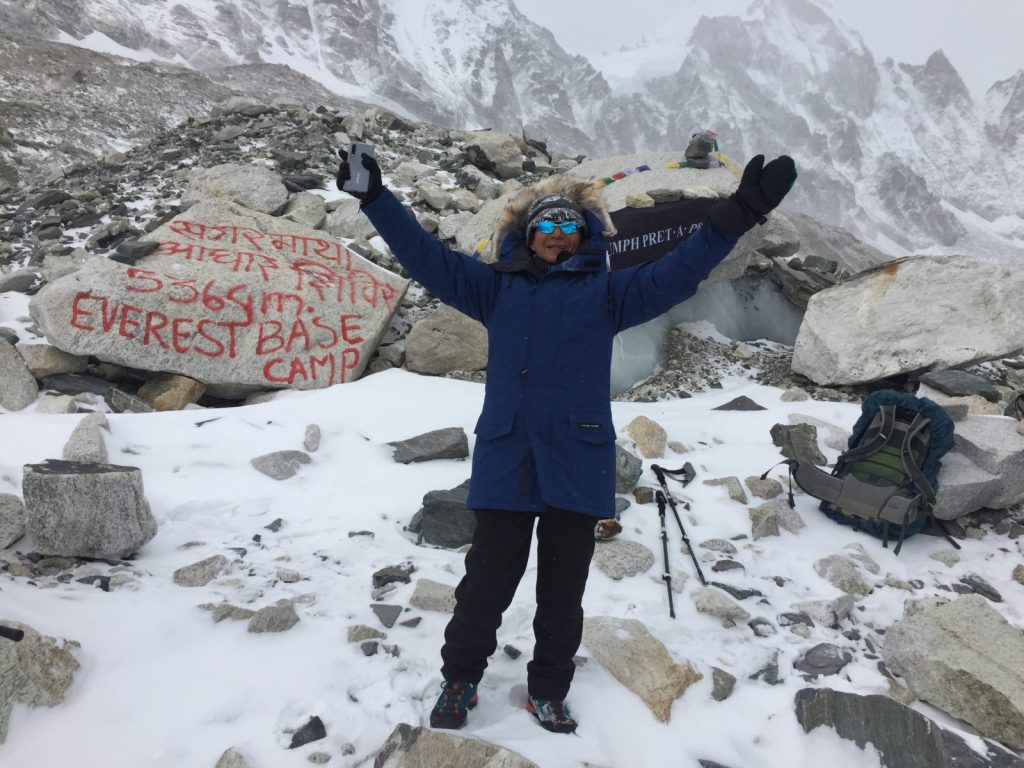
Everest base camp trek with the highest golf tee-offs by a foreigner. I took Harry Tan, a 71-year-old trekker from Singapore, to Everest base camp on a trek (not a climb to the top). I devised the idea to make this a trek to Everest base camp with a twist. This idea came to me on the morning of 7th December as he was flying here to make him tee off from 3 places above the altitude of 5000 meters. I had known him since 2015 when he came to golf with members of the Seletar golf club before the massive earthquake on 25th April 2015. He did a short trek in 2016 and was here in March this year with other club members. He is a keen golfer and part-time Physical Education teacher at Nanyang Technical University. 8th to 13th December 2019. We did this trek on our regular itinerary by flying to Lukla, trek to Namche, a side acclimatization trek to Amadablam base camp, etcetera. We hiked to Dingboche according to our plan. It started snowing lightly on the 6th morning from around 6.30 am. Upon reaching Dingboche, we stopped in a shop so Harry could buy warmer gloves, as the two pairs he brought from Singapore were not doing the ‘job.’ So instead, he ended up buying a pair of feather mittens. We just hung around the lodge, eating/drinking hot food and beverages. It continued to snow lightly for around 22 to 24 hours with occasional short breaks. 14th December 2019 We started our hike on a partially cloudy/foggy morning in the snow between 30 and 50 centimetres in depth. Despite December being the slow season, 70 to 100 other trekkers were on the trail. We reached our destination Lobuche 4940 meters, at 4 pm with the boots all damp. 15th December 2019 This was a massive day as Harry would be teeing off from 2 above 5000 meters. It began snowing lightly from 7 am, with the wind swirling up the valley behind us, blowing snow/sand. We hiked for about 90 to 100 minutes before reaching the flattish ground on Lobuche pass to Gorakshep 5180 meters. We stopped to bring out our 3 Wood driver, rubber tee, and an ecobioball manufactured by Albusgolf. These balls were imported from Europe 3 years ago for my project. It was a complete whiteout when Harry did the first-ever 5000-meter tee-off by a foreigner, a fellow Singaporean; Mark arrived just in time to witness this feat. We became friends six days ago in Namche Bazaar and crossed paths regularly on the trail. We continued on the lateral moraine towards Gorakshep. We had a quick lunch and left for the Everest base camp. We were the last to reach EBC and planned to avoid unnecessary attention from other trekkers. However, the other trekkers talked about a Singaporean with a golf club and wondered what he would do with it. We reached EBC trudging through snowy/icy conditions with strong wind gusts. Harry had to practice his swings with five layers of jackets in cold and windy conditions, not an easy feat for someone from sea level and a warm tropical country. Nevertheless, he managed to get an excellent swing. We headed back to Gorakshep for the night. Unfortunately, we learned that the overnight temperature was between -18 to -20 degrees Celcius. 16th December 2019 This was another significant day as Harry was going to tee off from Gorakshep at 5180 meters, and as it was a very clear day, once more from Lobuche pass. So Harry teed off from Gorakshep and Lobuche pass (a world difference between a foggy morning and a bright sunny day). We stopped at Pheriche and not Pangboche as planned due to the conditions of the trail. We had been walking on snowy/icy trails for the fourth day. 17th December 2019. We had planned to reach Namche Bazaar on this day. Instead, we had a gloriously bright morning with 360-degree views. Shomare the first settlement after leaving Pheriche, took us nearly two hours in snowy and icy conditions. On regular days it is only a 45-minute hike. There are patches of very icy trails where communal taps are left running to avoid pipes bursting below freezing temperatures. Before reaching Pangboche (standard time 90 minutes), which had taken us more than 3 hours, I gave Harry the option of flying down to Lukla by helicopter, bypassing these treacherous conditions and avoiding getting injured. Harry was happy to fly by chopper as it would also be his first experience. First, however, we had to wait a few minutes for the helicopter to bring cargo on a sling to arrive, leave the load, and get us to Lukla. We arrived in Lukla after a short 7 minutes but a thrilling flight by helicopter. We had a relaxing afternoon in Lukla, basking in the sun, having a warm shower, and the last night’s party with our talented staff Sundar Rai. 18th December 2019. We got to the airport terminal at 8 am and had a three-hour delay. We had to wait in the cold airport terminal. We were happy to leave Lukla when our aeroplane finally arrived. Harry was dropped off at his airline office to change his flights and was free to sort out his things for the afternoon. 19th December 2019 We dropped into the airline’s office to upgrade Harry’s flight before heading to the airport. Finally, we bid adieu at the airport; another innovative adventure ended. Conclusion. We are trying to get a few media companies to print this story. No matter what others may think or say, I think this achievement is no ordinary feat. It is unlikely to be matched or beaten for some time to come. The combination of a 71-year-old foreigner, trekking to EBC in the winter snow, and teeing off above 5000m is a difficult act to put together. This story of this incredible feat was published in a reputed National weekly
Teeing off while on a trek? Why not?
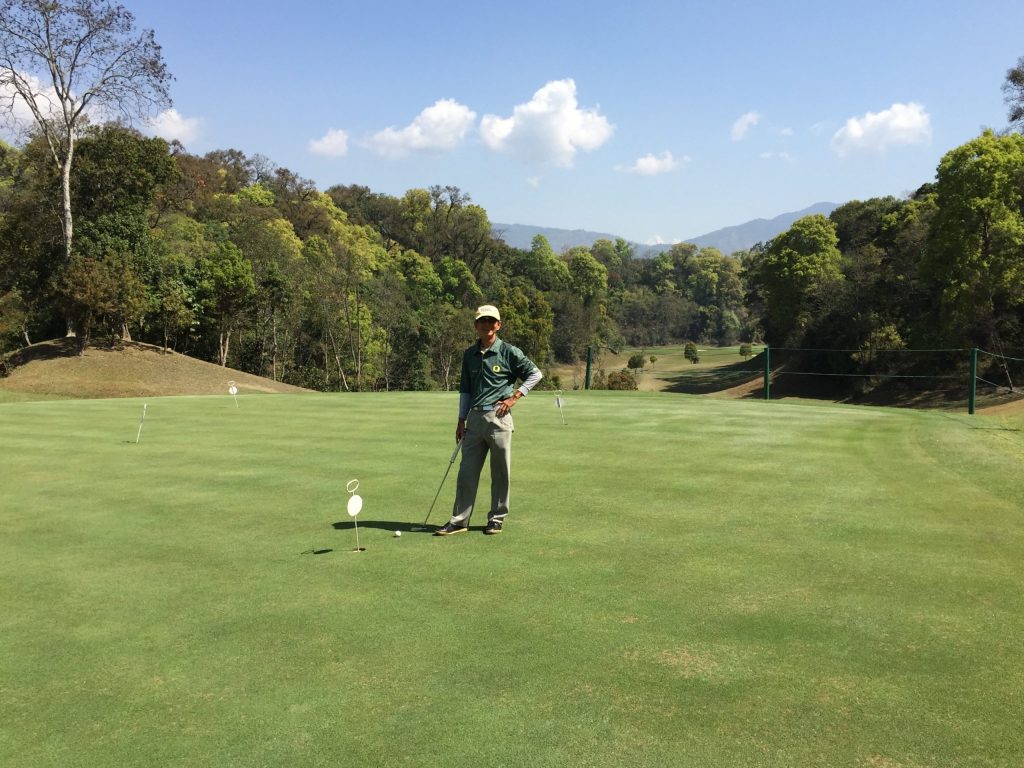
Are you teeing off while on a trek? Why not? Raj Tamang, the founder of Responsible Adventures, came up with the idea of teeing from venues above 5000 meters from as many places as possible. So he has tee-offs from Throrung La pass, five passes above 5000 meters in the Upper Dolpo region, and six tees-off from the Gokyo Lakes and Everest Base camp areas. This is probably a world record of sorts. He has played 18-hole golf twice and nine-hole golf once. Hence, he isn’t a regular golfer at all. He did this to do something no one else had done. We collected all the golf balls for those concerned about leaving golf balls in the mountain environment. We even used biodegradable golf balls from Spain in case we lost one. This project started in September 2016, and the last tee-offs were done in December 2017. Read more Check out our Trekking packages for Nepal, Bhutan, India, and Tibet.
Our founder’s interview on tourism on Nepal’s premium weekly newspaper Nepali Times.
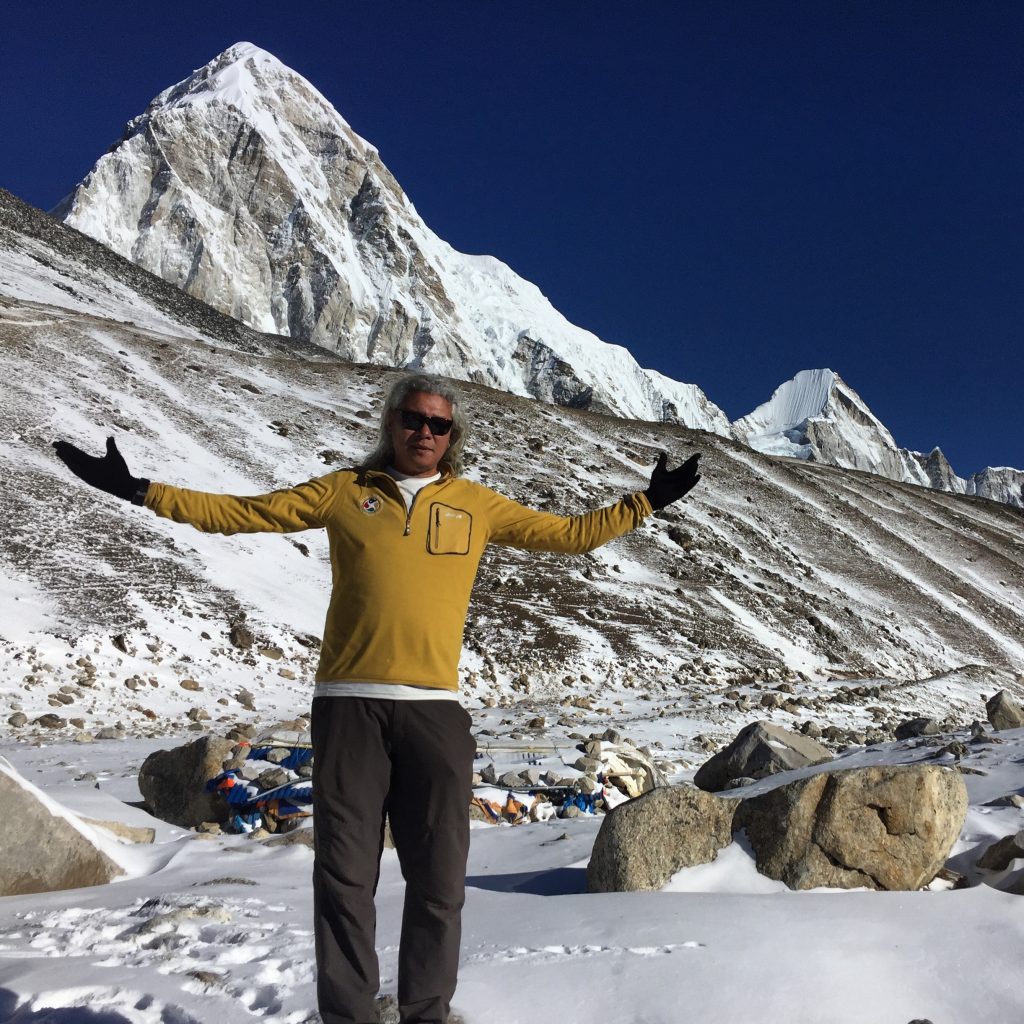
Selling Ourselves Short Our founder’s interview on tourism on Nepal’s premium weekly newspaper Nepali Times. Selling ourselves short For years, Nepal’s tourism industry has lamented that the country has gone for quantity rather than quality. They point to Bhutan, which has prided itself as a premium destination, as Nepal’s model should have followed. Read more:
Sano Babu Sunuwar Took Off From The Summit Of Mount Elbrus
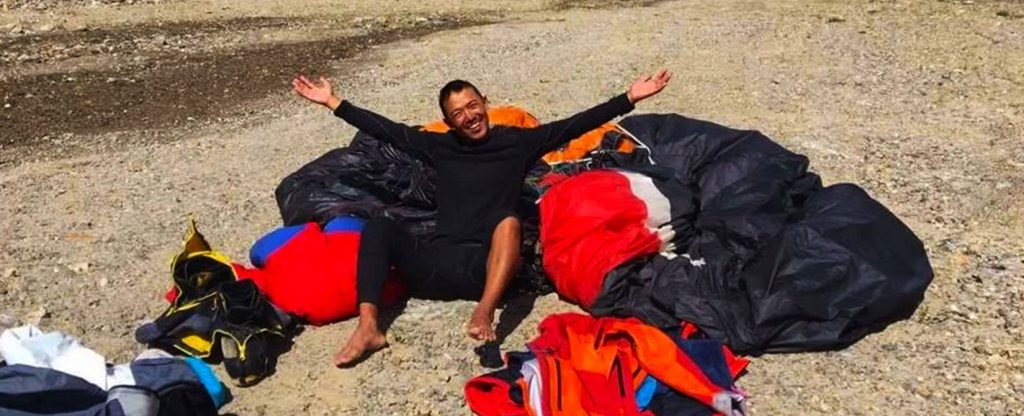
Sano Babu Sunuwar Took Off From The Summit Of Mount Elbrus Congratulations to Sano Babu Sunuwar, who took off from the summit of Mount Elbrus. Mount Elbrus is the 3rd of the Seven Summits. He is attempting to take off on a paraglide. He has already launched his Paraglide from Mount Everest and Mount Kilimanjaro summits. Previously, he set the world record by jumping off Mount Everest’s summit on a paraglide and kayaking down the Dudh Kosi river to the Bay of Bengal. He and his fellow adventurer Lakpa Tsheri Sherpa were named in 2012 by National Geographic (NatGeo). Hats off to this unique adventurer! He has started a new trend in Russian tourism – commercial tandem paragliding from Mount Elbrus. Experience our unique adventure sports combination of trekking to Mardi Himal’s base and paragliding to Pokhara with the company owned by Babu Sunuwar. Check out our Trekking packages for Nepal, Bhutan, India, and Tibet.
Ra Collaborates On Environmental Protection Education For School Kids In Kathmandu
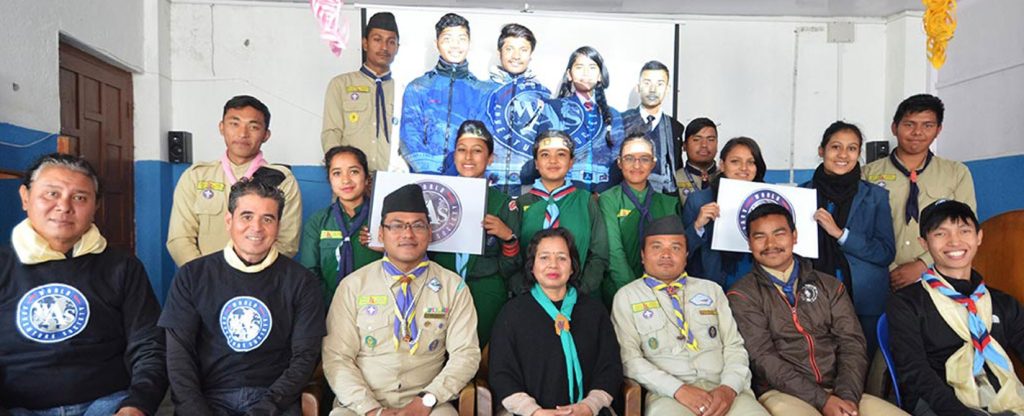
Ra Collaborates On Environmental Protection Education For School Kids In Kathmandu Founder Raj Tamang and other World Adventure Society ambassadors, Sunil C. Sharma from Nepal and Jia Jian Koh from Singapore, delivered an environmental protection lesson based on “Leave No Trace” principles for secondary and high school students in the Lalitpur district of Nepal. This may be the first of many such collaborations among the Asian WAS. Asian Was ambassadors plan to combine the ambassadors to grow the World Adventure society’s reach. On 18th December, Vajra Academy was the venue for the day one session. The school is environmentally savvy as it has adopted many sound environmental practices. The school runs its entire kitchen on renewal energy, such as solar and biogas. It is situated on the outskirts of the Lalitpur district in the Kathmandu valley. Visit the school at this location. The ambassadors observed that the students were highly disciplined and knowledgeable. They took a good part in the question and answer session and were very engaging. They were given practical knowledge on avoiding or minimizing the impacts of our outdoor pursuits on Mother Nature. They also learned ways to be safe and considerate to other outdoor users. On 19th December, the ambassadors reached out to Sudesha High School, located at Bhainsepati. The Ambassadors conducted two sessions, one for a small sub-segment of Lalitpur district Nepal Scout and the other for a grade of 7 and eight students. Both the Sessions were organized by Rover leader Mr Satya Narayan Shahi of Nepal Scout Lalitpur district. The Nepal Scout organized this session very professionally. The School Principal, Mr Madhusudan Lohani, chaired the meeting. Ambassadors received a very cordial welcome from the Scout cadets. National Anthems of Nepal and Singapore were played to start the session formally. The Ambassadors were captivated by the level of enthusiasm from the students to learn and discover more. They kept fielding one good question after another one, which benefited everyone. The mature students even asked if they could become a member of the World Adventure Society. This was very encouraging to hear that they wanted to be WAS members at such a tender age. This is a good sign that WAS is a beaming positive image to the world. We want to thank Ms Achala Thapa of Nepal scout, who helped coordinate the two-day training sessions at various schools. It is part of our Responsible Tourism practice. Check out our Trekking packages for Nepal, Bhutan, India, and Tibet.
A new minister of Culture, Tourism and Civil aviation appointed
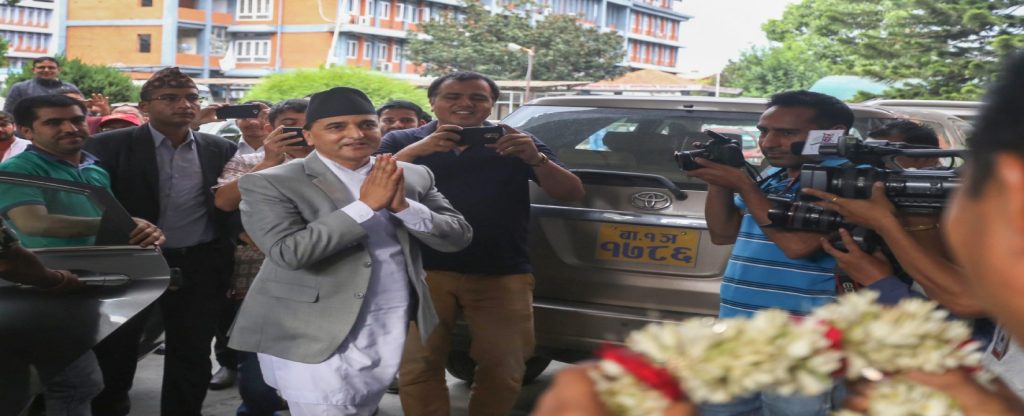
A new minister of Culture, Tourism, and Civil aviation was appointed. The vacant administration leadership at the Ministry of Culture, Tourism, and Civil aviation were appointed after the then tourism minister Rabindra Adhikari’s unfortunate death in February 2019. After five months after the then minister’s demise, Mr Yogesh Bhattarai was named the new Tourism minister. Mr Bhattarai’s appointment has come when building different airport projects. In addition, the “Visit Nepal Year 2020” tourism drive arrangement has stagnated; furthermore, the national carrier – Nepal airline corporation- has been struggling financially for survival. In these circumstances, two journalists of a reputed English daily – The Himalayan Times (THT), caught up with the tourism minister to learn how he intends to address these concerns and push the country’s tourism sector. Photo: Naresh Shrestha/ THT THT: You have been selected as the tourism minister at a critical period when the nation is grappling with accomplishing its tourism aims. What will be your topmost priorities? Tourism Minister (TM): I am taking notes of all data currently associated with developing the ministry’s schemes and other obstacles in the nation’s tourism sector. We will develop a one-year work plan as soon as I gather crucial details on the current developments and hurdles from relevant bureaus, including the ministry. Presently the tourism sector contributes only seven per cent to the country’s GDP, while it has received nearly 1.2 million tourists. This is certainly unacceptable. The tourism sector can be indispensable in reducing inequality economically, achieving sustainable growth, and promoting entrepreneurship. In addition, the tourism industry is significant in strengthening Nepal’s bilateral relations with different countries and reducing gender and social inequalities. Therefore the tourism industry has to be under the government’s planned preference. THT: What is your evaluation of the present difficulties facing the ‘country’s tourism sector? Tourism Minister: There are immense obstacles. Fundamentally, the lack of a good and quality tourism foundation has always been the principal bottleneck for tourism trade growth. Likewise, the country’s tourism database and information movement are limited. As a result, we have not been able to generate enough tourism products while the existing products lack important branding and promotion on the international market with unique selling points. There is an urgent need to efficiently prepare all diplomatic agencies that Nepal has in various countries to market Nepal’s tourism sector. Alongside this, the government offices and the private sector need to be mobilized efficiently. It is also evident that the tourism sector has not received the excellent precedence it deserves. This will not occur during my tenure. THT: Despite the nation commemorating 2020 as the “Visit Nepal year” to market tourism, the tourism fraternity appears unhappy with the preparations. How convinced are you? Tourism Minister: It is true that the arrangements for the tourism campaign are slack and have not attained the level they should have. One of the reasons behind this setback was the absence of political leadership at the ministry for the past five months. However, the department will now work on extra programs and packages to target the Visit Nepal Year 2020 campaign. All the programs will promote the nation’s tourism globally while coordinating with international media to promote Nepal’s tourism further. Coordination with other globally distinguished tourism agencies and governments of different nations will make Visit Nepal 2020 a grand success. THT: The national flag carrier – Nepal Airlines Corporation (NAC)- is vital in promoting tourism. However, it has been grappling financially for the past few years. How do you plan for NAC to step up? Tourism Minister: We have no option but to step up our national flag carrier’s strength. We need to address the predicaments it is currently facing as Nepal Airlines, and its services are directly linked to Nepal’s identity. Therefore, the initial step towards strengthening the national carrier will be to analyze the difficulties it has faced in recent years. A research panel will be formed by me, whose job will be to recognize issues hindering NAC’s growth. Numerous studies have already been carried out concerning ‘NAC’s failure to operate as a competitive government bureau. Accordingly, the government will make necessary decisions concerning NAC’s operation modality based on the past report’s findings prepared under my leadership. According to recommendations and necessity, we can either restructure NAC’s administration, bring in a strategic partner, or even appoint a corporation’s management partner. Any modality adopted for NAC will have to be result-oriented, and this factor will be kept in mind when making any decision. Nepal Airlines Corporation has been supported financially by the government, but this trend must be stopped and made self-sustainable. Minister Bhattarai claimed that he was optimistic that NAC’s predicament would rapidly improve its financial state, services, and management. THT: How do you intend to approach the European ‘Union’s embargo on Nepalese airlines? Tourism Minister: Unfortunately, the EU has continued to embargo Nepalese airlines. Nepal has maintained strong bilateral relations with countries in the EU. Additionally, the United Kingdom, France, and Germany, among other Eu nations, have been those Nepal’s embassy for decades. Consequently, Nepal will continue to strengthen its relationship with EU nations. One of the essimportantys to do so would be lifting the ICAO-imposed ban on Nepalese airlines, allowing them to expand their flights to EU countries. I will work hard toward addressing all the concerns and questions raised by the EU during my tenure in the aviation sector. Moreover, my importance will be to get the ban imposed by the EU lifted. Minister Bhattarai said, “Moreover, my emphasis will be to lift the ban imposed by the EU on Nepal airlines by addressing their pressing matters through discussions and consultations with the EU and other stakeholders. THT: The completion deadline of Gautama Buddha International Airport (GBIA) has been extended repeatedly. How positive are you that the new completion deadline of the GBIA in December will be met? Moreover, the necessary groundwork related to new air routes and flight operations has not yet been finalized at the airport. Minister Bhattarai: The government has
Travel Updates Nepal
Nepal Travel Updates Almost 18 months have elapsed since the massive earthquakes of April, and May 2015 struck Nepal and brought about significant mayhem then. Back then and in the immediate aftermath, the world was under the impression that all of Nepal was flattened. The fact is, only 14 out of the 75 districts were affected by the earthquakes. Several historical monuments were destroyed or partially damaged. Restoration work is in progress at many of these UNESCO heritage sites. Boudhanath Stupa restoration is reported to be completed six months before the schedule. The effects of the earthquakes were shattering the tourism industry. Foreign offices warned their citizens to avoid unnecessary travel to Nepal. As a result, the visitor arrival dropped by two-thirds for the first 8 to 10 months post-earthquake. Just as the Nepalese people were recovering from the damages brought about by the earthquakes, an unofficial trade embargo at the borders with India brought more difficulties to the nation, bringing all economic activities to a grinding halt. On the positive side, although there was no denying the hardships brought about by the earthquakes and the Indian border impasse, it was a pleasant surprise and relief that few braved to visit Nepal to discover a different side of the Nepalese story. The story of the resilience of Nepalese people. All Western countries, including the USA, UK, Australia, Germany, Denmark, and Norway, have removed the travel warning to Nepal, deeming it safe for a visit. 37 Countries have officially listed trekking trails reopened for hiking after extensive safety checks and repairs. Many tourism stakeholders were poorly affected; some were on the verge of bankruptcy. Fortunately, everyone stood steadfast in supporting and encouraging one another. Several events and meetings were held on reviving tourism and promoting visitors to the country with messages that Nepal is safe again. In the meantime, domestic tourism was encouraged, and it was a significant success in helping sustain the entrepreneurs in the travel trade business. Optimism is high in the air amongst tourism entrepreneurs. New Hotels are under construction, new restaurants are sprouting up, and more investments are made in other tourism infrastructures. Boutique hotels are springing up in the main cities of Kathmandu and Pokhara. There are reports on blog papers, magazines, and posts on Social media about how the travel inquiries are gaining momentum again – all positive signs of improvement. The autumn season is believed to be the busiest period for Nepal. However, if the tourist arrivals increased by 13% in the first six months of this year, the tourism industry stakeholders are optimistic that better days are just around the corner. Now the visitors can once again enjoy our World Heritage sites, diverse cultures, and numerous adventure activities such as mountain biking, rafting, kayaking, canyoning, paragliding, ultra-lite flights, zip line, mountaineering, and hiking in the world-class trekking trails in the Himalayas and Kathmandu Valley’s prized sites. Your visit to Nepal means contributing to the tourism industry’s speedy recovery after the natural disaster. Check out our Trekking packages for Nepal, Bhutan, India, and Tibet.
Mount Everest to be cleaned up of garbage and corpses
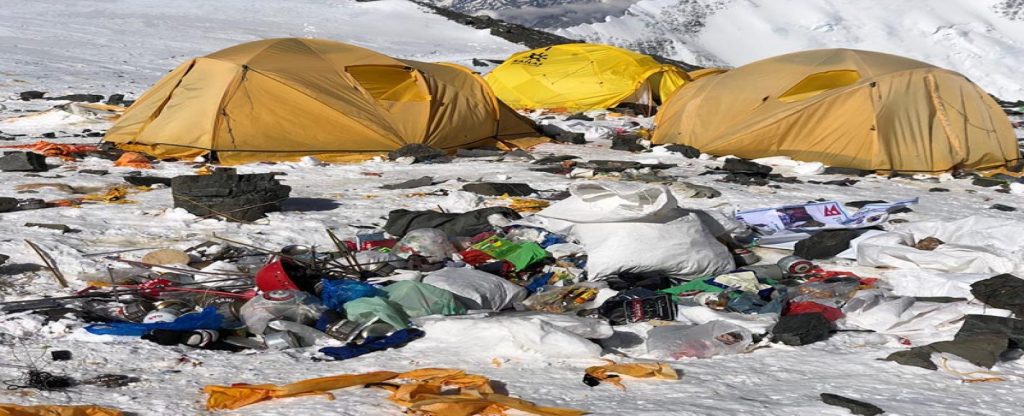
Mount Everest to be cleaned up of garbage and corpses. To keep the world’s highest mountain clean, Nepali Mountaineering expedition operators are ready to launch a joint effort, a massive drive to clean Mount Everest this spring season of 2019. The combined initiative, which the government and non-government agencies plan, intends to collect dead bodies and trash left behind by the climbers from the South Col-Camp 4 and Camp two of Mount Everest. Mountaineers have long been treating Everest as a dumping ground by abandoning oxygen bottles, cans, ladders, wrappers, faeces, and bags filled with faecal matters in the higher camps. The worst affected areas are the South Col at 7900 meters and Camp two at 6500 meters every year during the spring climbing season. As a result, it has been estimated that more than three hundred bodies of climbers are left behind. The base camp will be established by the third week of April when the stakeholders plan to start this colossal event. There will be two groups of assigned Sherpas consisting of five members each. They will be deployed at Camp two and the South Col to collect and pack the trash. The climbers, along with their support crew who rotate to Camp two and South Col to acclimatize, will bring the packed rubbish to the base camp. Those who bring down the trash will be rewarded financially. The Department of Tourism has estimated that around 500 foreign climbers and more than 1000 climbing crews will be visiting the higher camps on Everest this season while preparing to scale the highest peak and Mount Lhotse 8501 m, the fourth highest mountain in the world. The Department of Tourism’s record shows that more than three hundred foreign climbers, along with their support crew, have left for the Khumbu region on their attempt to climb Mount Everest and Lhotse. Most of the Mountaineers make a final push for the summit in the third week of May. The Department of Tourism’s Director General Dandu Raj Ghimire claimed that it will be the largest ever cleaning campaign on Everest during a press conference. He said, “We expect to bring hundreds of tonnes of garbage from the higher camps on the mountain this season,” encouraging the climbers from the world over to join in on this noble cause to clean up Everest. The government has been unsuccessful in implementing it is 2014 mountaineering rule, which states that every member of an expedition team has to bring back at least eight kilograms of garbage besides their trash from expeditions on Mount Everest, Lhotse, and Nuptse; many commercial expeditions have left behind tonnes of waste all over the mountain. “However, this upcoming event should be successful,” Ghimire wishes. Ministry of Culture, Tourism and Civil aviation, Environment, Nepal mountaineering association, Nepal army, Khumbu Pasang Lhamu rural municipality, Sagarmatha Pollution Control Committee and Nepal Tourism Board have decided to take an active role in this campaign. Tika Ram Gurung, the Nepal Mountaineering Association secretary, hopes that most high-altitude support staff who bring loads to the higher camps will responsibly descend with the garbage. “They will not be just making extra income but contributing in a big way towards this noble cause,” he said. The price per kilo of garbage brought down is yet to be determined and is currently in discussion. The estimated cost for this campaign is Rs3 million. This campaign is funded by several sponsors, such as The Coca-Cola Company, the World Wildlife Fund, financial institutions, and private businesses. The Chairman of the Sagarmatha Pollution Control Committee (SPCC), Ang Dorje Sherpa said, “This campaign will be continued in the years to come”; he also said that this campaign would be facilitated at least two ‘icefall doctors’ in the higher camps. “SPCC will be monitoring the activities of this campaign from base camp,” he said. “Non-biodegradable garbage will be flown back to Kathmandu.” Dambar Parajuli, the Expedition Operators Association of Nepal ( EOAN) president, said that EOAN would back the campaign. “All climbers will happily contribute,” he added. Check out our Trekking packages for Nepal, Bhutan, India, and Tibet.
The Everest region to ban plastic bags and bottles from January 2020

The Everest region to ban plastic bags and bottles from January 2020 The local government will ban plastic products below thirty microns, including beverages in plastic containers, from January 2020. The Everest region is all set to become a plastic-free zone. Having struggled for decades with piles of garbage in the Everest region, which has caused to gain unwanted notoriety as the ‘world’s highest garbage dump,’ the local administration has approved a plan to declare the entire area a ‘no plastic’ zone from next year. The Khumbu Pasang Lhamu Rural Municipality of Solukhumbu district has decided to impose a ban on plastic bags, bottles, and other products, indicating their adverse impact on human health, especially in the whole of this region. According to the Chief administrative officer, Ganesh Ghimire, this rural municipality has decided to use plastic bags with less than thirty microns to be prohibited in this region while passing its policies and programs for the current fiscal year. Even bottled drinks will be banned from the area with the new rule. Only beverages packaged in cans will be allowed from January onwards. “The home to the tallest mountains in the world has witnessed havoc created by plastic in this fragile region over the years,” said Mr Ghimire. “The Everest region keeps getting inundated with plastic with the growing number of visitors. Therefore, this initiative is necessitated to get rid of plastics from this region.” According to Mr Ghimire, no one – be it locals or tourists- will be allowed to bring or use plastic bags and bottles inside the rural municipality once the rule is implemented. “We will only allow canned drinks since cans are less environmentally hazardous than plastic. The locals will also recycle the cans,” Mr Gimire said. However, he also noted that imposing such a strict ban was essential as the region is plastered with plastic products. “We will only allow canned drinks because cans are not as hazardous for the environment as plastic. Locals can also recycle cans,” Ghimire said. “It was necessary to impose such a strict ban because the region was plastered with plastic and other items made of plastic.” This region has also been struggling badly with solid waste management contributed by the visitors to this area year in and year out. Several hundred mountaineers, climbing Sherpas, guides, and other high-altitude support staff en route to Everest leave behind tonnes of biodegradable and non-biodegradable wastes such as empty oxygen canisters, bottles, kitchen waste, ropes, and faecal matter. All of this results in the pollution of the area and the settlements downstream. The government rule that every climber must bring back at least 8 kgs of garbage—the estimated amount of trash generally produced by each climber on average—has continued to be mostly unproductive. A 45-day ‘Everest Cleaning Campaign,’ led by the rural municipality that various governmental and non-governmental agencies supported, had brought down nearly 11,000 kgs of garbage from the world’s tallest peak earlier this year. Plastic in multiple forms and sizes was the major item in the collected trash. This campaign was one of the most ambitious clean-up projects conducted on Everest at a cost of more than RS 25 million. “Asides from disturbing the natural environment, a large amount of money has to be spent annually to clear all this garbage,” said Ghimire. The local authority will distribute five alternative bags free of cost to each resident in this rural municipality. There are roughly 2000 households. One of the biggest fears the local authority has is the worsening of plastic pollution with the opening of a road that connects Kharikhola in ward-1 of the rural municipality with Chaurikharka in ward-3. According to the rural municipality’s estimate, nearly 150,000 tourists use this route annually. The number will rise to as much as half a million next year. “More tourists/trekkers on this route could mean more plastic in the region,” Mr Ghimire said. “The time is right to prohibit plastic here before we face an unusual amount of plastic soon.” Yoga Retreats in Nepal Check out our Trekking packages for Nepal, Bhutan, India, and Tibet.


